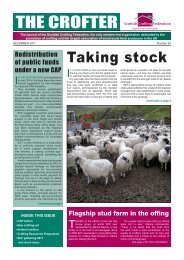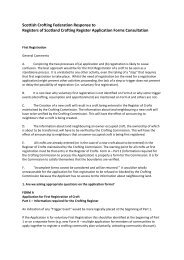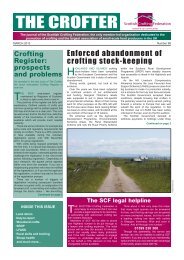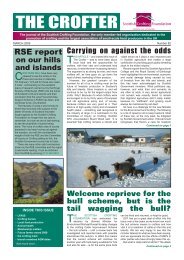draft report - Scottish Crofting Federation
draft report - Scottish Crofting Federation
draft report - Scottish Crofting Federation
You also want an ePaper? Increase the reach of your titles
YUMPU automatically turns print PDFs into web optimized ePapers that Google loves.
4 Planning<br />
The research brief asked the researchers to identify the constraints which are preventing the release of<br />
land under crofting tenure, to relieve housing pressure . Crucial to whether croft land particularly common<br />
grazings land can be used for housing are the planning policies of the planning authorities covering the<br />
crofting counties. These policies interpret national guidance relating to planning to the local circumstances.<br />
This chapter outlines national planning policy in relation to housing in the countryside, rural development<br />
and affordable housing; and the interpretation of national planning policy by the six planning authorities in<br />
the crofting counties<br />
4.1. National Planning Policy<br />
4.1.1. SPP3 Planning for Housing<br />
The main national planning policy relating to housing is SPP3 Planning for Housing, this outlines a general<br />
presumption against housing in the countryside; development is to be restricted to sites within existing<br />
settlements: and ribbon development and settlement coalescence is to be avoided. However in remoter<br />
rural areas policy recognises that new housing outwith settlements may have a part to play in economic<br />
regeneration and environmental renewal. In remote rural areas with substantial long-term depopulation,<br />
proactive planning measures to help increase the resident population could assist economic and social<br />
regeneration. A dispersed settlement pattern is already an established feature of the landscape and<br />
economy in crofting areas. 27<br />
4.1.2. SPP 15 Planning for Rural Development<br />
Building on the provisions of SPP3, SPP 15 Planning for Rural Development, highlights the potential for<br />
more small scale rural housing developments including clusters and groups in close proximity to<br />
settlements stating that there is considerable scope for allowing more housing developments of this<br />
nature 28 .<br />
It goes on to state that some new housing, particularly in the remoter countryside, takes place on land not<br />
identified in local plans and outside settlements where there is reduced pressure on the retention of<br />
woodland and other amenity land. While this can help keep land prices down and allows a wider range of<br />
people to access the market, planning authorities should set out criteria in their plans for the<br />
circumstances where this type of windfall development, outwith the main settlements, is likely to be<br />
acceptable 29<br />
Houses on <strong>Crofting</strong> Land Rural Housing Service 2007<br />
18










